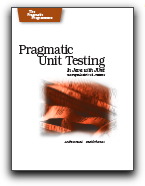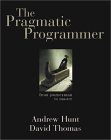Monthly ArchiveFebruary 2004
Technical 29 Feb 2004 12:31
Pragmatic Unit Testing
 Pragmatic Unit Testing – In Java with JUnit
Pragmatic Unit Testing – In Java with JUnit
Andrew Hunt & David Thomas
A very quick read, this book is a practical introduction to unit testing, aimed at programmers without much experience in this area (like me). It focuses on Java, and specifically on the use of the JUnit framework, but the essencial ideas are aplicable to whatever language one happens to use.
Reading this book you will learn not only how to create effective unit tests, but also why you should do so, and what you will gain from them. It also gives you lots of arguments to try to win your colleagues and management over and try to introduce unit testing to your company’s culture. You will learn about what you should test, when the tests should run (always), why you should automate your build and testing cycles (which is probably a plug for their next book, “Pragmatic Automation”, due later in 2004), how to write tests so that you are more likely to use them, and so on.
You should probably read this book (and/or its companion, “Pragmatic Version Control”) right after reading “The Pragmatic Programmer”, like I did. You will still have the ideas of the previous book fresh on your mind, and you will be more inclined to apply what you learn. Even if you have a good amount of experience with unit tests, this book can still probably be useful, by helping you refresh what you know and, maybe, learn something new about the subject.
Technical 28 Feb 2004 21:35
The Pragmatic Programmer
 The Pragmatic Programmer – From Journeyman to Master
The Pragmatic Programmer – From Journeyman to Master
Andrew Hunt & David Thomas
I recommend this book to any programmers out there, specially those who are early in their careers. It contains chapters dedicated to several topics related to the craft of programming, and each one of them will make you a better programmer.
You certainly won’t learn how to program from this book. No language is taught in it, and it expects that you already know how to program and are familiar with the usual cycle of software development. You will probably already know several of the techniques it discusses, or you will at least have heard of them, even if you don’t follow them. Still, the book is written in a way that encourages you — nay, it almost physically pushes you — to go make them part of your regular job.
In a way, the essence of the book is in the pull-out card included right before the back cover: the 70 “tips” that are sprinkled throughout the text, containing all of the combined wisdom of the authors in easy-to-swallow nuggets. For example. tip 49: “test your software, or your users will”. Or my favourite, tip 25: “don’t panic when debugging”. The list of tips is freely available from their website, by the way.
But you shouldn’t read just the tips; the text of the book gives out much more detail, in an easy and fun way, with lots of real-life examples. It will sound like a cliché, but I really wish I had read this book some ten years ago, and I do intend to make sure that all programmers who work with me read it.
So, if you care about your craft (which, by the way, is tip number 1), go get this book or find someone who already has it. In the meantime, you can read some excerpts at the afore-mentioned website.
Fiction 22 Feb 2004 21:56
Hackers
 Hackers
Hackers
Jack Dann & Gardner Dozois (ed.)
This book has nothing to do with the similarly named movie. Thankfully.
What it is, instead, is a collection of short science-fiction stories that talk, loosely, about hackers of various types. There are the regular computer and network hackers; there are underground crackers; there are the “bio-hackers” who work their magic with DNA nucleotydes instead of bits; there are those who only hack in order to prevent others from hacking; and many others.
The collection, edited in 1996, includes stories by well-known names such as William Gibson, Bruce Sterling, Greg Egan and Neal Stephenson. In all, it features thirteen stories in several different styles, each of them a good read in itself. All together, they make a great book.
My favorite story of the whole set is Bruce Sterling’s “Our Neural Chernobyl”, which was written as if it were a book review which ends up discussing the unintended consequences of a break-through in the field of neurochemistry. And, in doing so, it brings out so many new ideas that one could probably write several books with them. Sterling wrote only a 9-page story, though, and leaves the reader wishing for more.
Fiction 15 Feb 2004 11:10
Eastern Standard Tribe
 Eastern Standard Tribe
Eastern Standard Tribe
Cory Doctorow
One of the original things about this book is that the author released it online, for free, under a Creative Commons license. What that means is that you can download it, print it, even redistribute it, provided that you do not make commercial use of the material and do not remove the author and license information.
There is, however, no reason to pay more attention to the media more than to the content. The story of the book is very original as well, and makes for a gripping book.
The premise is that, with the world being more connected each day, there is a good chance that the people and the culture that you feel more connected to are not the ones “local” to you. Information flows too easily, and people know more about other parts of the world than they did at any time in the past. Thus, you’re not stuck with the culture, friends, family and neighbours you were born with: you can pick your own! Selecting people with interests, opinions and ways of life that are similar to yours, and picking from anywhere in the world, you can form your own circle of friends, even if it’s made entirely of people whom you’ve never seen.
However, it is very possible that most of them live somewhere else, in another timezone; they are probably clustered geographically, but they may not be that close to you. So, in order to connect with them, you need to follow their time patterns. Soon enough, you’re waking up in the middle of the night to talk to people who are at the beginning of their day; you also go to sleep very early, because that’s when they go to sleep. That’s it: you’re a member of the tribe now.
The book, set in a not-too-distant future, shows a world where tribes are semi-formal groups of people, with plans, agendas, spies and enemies. There’s the Eastern Standard Tribe of the title, but also the PDT, the GMT and so on. Our here, Art, is a ESTer infiltrated in GMT, acting as an agent provocateur; he’s also a brilliant UE (user-experience) engineer, and his ideas are what make the plot of the book click.
It’s a very good “social science fiction” book, and I recommend it as a good, light read.
By the way, the author has also wrote a short article for Wired, with the same title, where he touches on the same idea.
Buy from Amazon.com
Download for free
Fiction 14 Feb 2004 20:25
Quicksilver
 Quicksilver (The Baroque Cycle, Vol. 1)
Quicksilver (The Baroque Cycle, Vol. 1)
Neal Stephenson
First things first: this is one long book! And, being the first book of a trilogy, once you start to read it, you’re in for a long ride.
That said, this is also a great book. If you liked Cryptonomicon, you’ll certainly like this one; if you didn’t, maybe you should think twice before starting. Quicksilver is related to Cryptonomicon, although I wouldn’t go as far as calling it a prequel, as some did. Some of the characters of one book seem to be related to characters of the other, though.
Quicksilver takes us back in time, to the 17th century Europe (some bits take place in America as well), where we follow the first steps of what was going to become science. Real characters are mixed with, hmm, not-so-real ones, and accurate historical depictions of events share the pages of the book with fictitious passages. Thus, we see Isaac Newton, John Wilkins, Christiaan Huygens and other “natural philosophers” discovering the scientific method and acting towards the world as children in a toy store; but we also hear from Daniel Waterhouse, founder of the Massachusets Bay Institute of Technologickal Arts, and Eliza, a financial genius who helped William of Orange to become King of England. Science, finance, sex and politics all mix up in the lives of our characters, while we get to see what Europe looked like during a time very diferent from today, but where much of today’s world started taking form.
The book is very entertaining, specially if you are interested in science and history, as I am. It was even more so for me, because when I started to read the book I had recently returned from a trip to London (where I bought the book, in fact), and most of the story is set there. The physical description of the city seems to be very precise, historically speaking, and all the big events of the time are in the book in some form (the Restoration, the great fire of London, the Glorious Revolution etc.). Also, the way regular people, nobles and scholars lived their daily lives are depicted in a way that is very interesting to read. And, of course, all this is set within a great story.
In short, I can’t recommend it enough. If you can, and if you liked the description above, go out, buy this book, and start reading it today. I’m serious.
Book 2 should be out in April, and book 3 in September. Meanwhile, after you read the book, check out the Quicksilver Metaweb for more information (historical and otherwise) on the events of the book.

